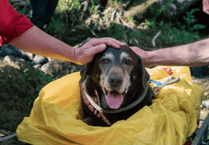ORGANISERS behind ambitious plans to reintroduce pine martens to Devon woodland in the autumn of 2024 are keen to allay fears of possible impacts on local wildlife, and this week they have launched an online survey to gauge public opinion.
The predator has been absent from the Devon and much of Great Britain for some 150 years after being hunted into near extinction and the loss of suitable habitat.
When the project to bring them back was first announced last year, some bird lovers and poultry breeders were soon up in arms about the plans. One year on, some were complaining they were being kept in the dark about the scheme.
One Dartmoor poultry breeder said: ‘I am glad that at last they have finally started to engage with us as I need to let them know how concerned I am about the plan. My birds are already vulnerable from foxes, badgers and weasels. Why threaten my business by releasing a particularly aggressive predator into woodland down the road?’
The survey is being managed by the University of Exeter on behalf of the Two Moors Partnership.
The partnership (TMP) includes the Devon Wildlife Trust, the Woodland Trust, the National Trust, Dartmoor National Park Authority and Exmoor National Park Authority. Two areas have been identified: northern Exmoor and nearer to home, Dartmoor, to include the Wray/Bovey Valleys and the area to the west of Bovey Tracey.
A trust spokesman said the TMP was going to engage with local farmers, breeders and stakeholders to gauge opinion.
He also said a series of workshops would be arranged where trust representatives would meet and discuss the plans. In response to this, the poultry breeder commented: ‘This was first announced last June. Back then we were told they’d be engaging with landowners and stakeholders. It’s taken a year and it all seems very last minute.
‘I took part in the survey as soon as I heard about it. It seems the questions are skewed in a way to get the outcome they want. As I completed it, it read almost like a foregone conclusion... I really hope they do engage properly as I would love to let my feelings be known.’
The DWT spokesman wanted to reassure bird lovers and breeders. He said: ‘Pine martens are opportunists. They feed on what is most abundant – primarily small mammals (particularly field voles) as their staple diet, with other foods forming more seasonal parts of their diet.’
He explained pine martens will feed on birds and eggs in spring/summer to supplement vole intake, mostly great tits and corvids such as crows, magpies and rooks, with other smaller, less abundant or less gregarious species forming only an opportunistic and small component of their diet.
‘Of course it will only be a small component,’ the breeder told this paper. ‘If there are fewer birds to feed on there’ll be fewer birds in their diet. They’ll impact wild species as well as my business. What they haven’t taken into account is avian flu and more importantly the Big Freeze of 2020 – We’re still feeling the effects of that.
‘I remember seeing scores of small corpses under hedgerows that winter and the numbers are only just recovering. The wild bird population is still vulnerable and I question the wisdom of bringing these aggressive predators back.’
The spokesman accepted the pine martens would prey on birds but wanted to reassure bird lovers it would eventually lead to a wider range of species.
He said: ‘Great tits are abundant nesting birds that displace other nesters such as pied flycatcher, while corvids are very effective nest predators of small birds. So while pine martens will predate a wide range of species opportunistically, their predation of these species is likely to create opportunities for other bird species and so create a net benefit.’
He admitted there were challenges to overcome, such as mitigating potential impacts on nestbox schemes and they’ll be working with key stakeholders to resolve these issues.’
A spokesman for Devon Birds, the county’s leading avian conservation group, said: ‘The re-introduction of pine martens is not a topic that Devon Birds has been involved with. We have no bird population information to supply to the project, nor have we been asked to.
‘We can only note that pine martens were previously a native mammal found across the UK and lived alongside a thriving bird population before being made locally extinct by persecution and loss of ancient woodland.’
One potential positive impact is that pine martens prey on grey squirrels – a voracious predator of eggs and young birds – and the trust hopes that their decline will allow the return of native red squirrel.
One Teignbridge farmer commented: ‘That seems daft! What’s to stop the pine martens preying on the red ones too? I really don’t think this has been thought through properly.’
The DWT spokesman said: ‘There is more work to do on understanding their long term effects, including how this can create opportunities to allow the return of native red squirrel.’
► For more information about the Two Moors Pine Marten Project, click here.
The survey will remain open until 9am on Monday, June 5 and responses are anonymous.
► To take part in the survey, click here.

-with-lightning).jpeg?width=209&height=140&crop=209:145,smart&quality=75)



Comments
This article has no comments yet. Be the first to leave a comment.